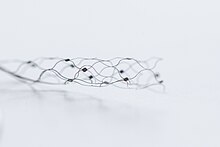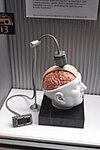Stent-electrode recording array

Stentrode (Stent-electrode recording array) is a small stent-mounted electrode array permanently implanted into a blood vessel in the brain, without the need for open brain surgery. It is in clinical trials as a brain–computer interface (BCI) for people with paralyzed or missing limbs,[1] who will use their neural signals or thoughts to control external devices, which currently include computer operating systems. The device may ultimately be used to control powered exoskeletons, robotic prosthesis, computers or other devices.[2]
The device was conceived by Australian neurologist
To date, eight patients have been implanted and are able to wirelessly control an operating system to text, email, shop and bank using direct thought through the Stentrode brain computer interface, marking the first time a brain-computer interface was implanted via the patient's blood vessels, eliminating the need for open brain surgery.The FDA granted breakthrough designation to the device in August 2020.[6] In January 2023, researchers demonstrated that it can record brain activity from a nearby blood vessel and be used to operate a computer with no serious adverse events during the first year in all four patients.[7][8]
Overview
Opie began designing the implant in 2010, through Synchron, a company he founded with Oxley and cardiologist Rahul Sharma.
The Stentrode device, developed by Opie and a team at the Vascular Bionics Laboratory within the Department of Medicine at the
The Stentrode technology has been tested on sheep and humans, with human trials being approved by the
Selected patients are people with paralyzed or missing limbs, including people who have suffered strokes, spinal cord injuries, ALS, muscular dystrophy, and amputations.[15][10]
See also
References
- ^ a b "Brain implant allows mind control of computers in first human trials". New Atlas. 5 November 2020. Retrieved 8 November 2020.
- ^ "Minimally Invasive "Stentrode" Shows Potential as Neural Interface for Brain". DARPA. 2016-02-08. Retrieved 9 February 2016.
- ^ "Stentrode with Thought-controlled Digital Switch: An Early Feasibility Study (EFS) of the Safety of the Stentrode Device in Participants with Loss of Motor Function Due to Paralysis". 29 August 2022.
- ^ PMID 33115813.
- ^ "Patients with Severe Paralysis Use Stentrode Brain-Computer Interface to Text, Email, Shop, Bank Online, First-in-human Study Reports – Neurosurgical.TV". 28 October 2020.
- ^ "Stentrode brain-computer interface receives breakthrough device designation from FDA". Neuro News. BIBA Medical. 28 August 2020. Retrieved 18 January 2021.
- ^ Lanese, Nicoletta (12 January 2023). "New 'thought-controlled' device reads brain activity through the jugular". livescience.com. Archived from the original on 16 February 2023. Retrieved 16 February 2023.
- S2CID 255545643.
- ^ "Synchron - Company Profile - Tracxn". 2 January 2024.
- ^ a b c d Stimulating the brain – without major surgery. Catriona May, The University of Melbourne. Published by Pursuit. 4 December 2018.
- ^ New device to get people with paralysis back on their feet. University of Melbourne. 8 February 2016.
- ^ Implant Stimulates Brain From Inside a Blood Vessel. Megan Scudellari.
- ^ "Brain-Computer Interfaces Evolve to Help People With Paralysis". interestingengineering.com. 2021-10-19. Retrieved 2021-10-24.
- ^ a b c Strickland, Eliza (2017-04-12). "5 Neuroscience Experts Weigh in on Elon Musk's Mysterious "Neural Lace" Company". IEEE Spectrum. Retrieved 2021-09-08.
- ^ A digital spinal cord that streams your thoughts. Thomas Oxley, TEDxSydney.
- ^ Articles·, FeaturedNeurologyNeuroscienceNeuroscience VideosNeurotechOpen Neuroscience (2020-10-28). "Small Brain Device Proves Big Game Changer for Severely Paralyzed Patients". Neuroscience News. Retrieved 2021-10-24.
- ^ PMID 33115813. Retrieved 18 January 2021.


